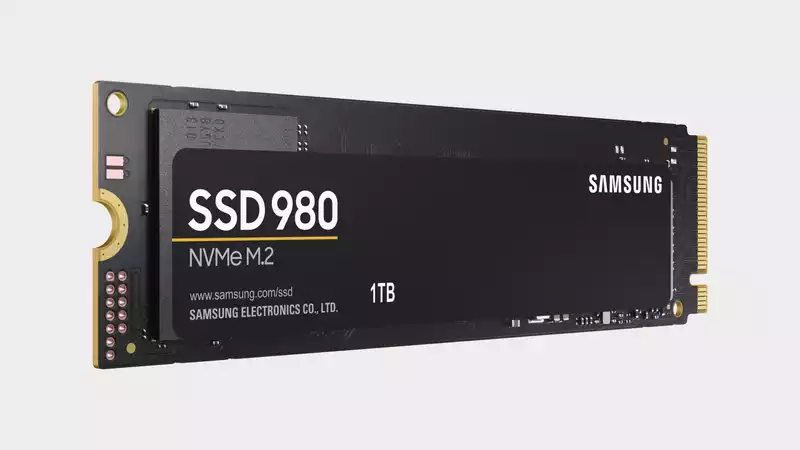The Samsung 980 is the latest M.2 NVMe SSD to hit the virtual shelves. Unlike the Samsung 980 Pro version that came before it, this is a PCIe 3.0 drive. Because of this, sequential read and write speeds are significantly slower than the previous model, with reads being half as fast and writes not even close; a 1TB model costs $130, or $0.13 per GB. [In addition to these 1TB drives, 500GB and 250GB SSDs will also be available. All drives use the same Samsung Pablo controller and are backed by the company's proprietary 6th generation V-NAND, the same as found on the 980 Pro. This 1TB drive is the fastest of the three because more channels of the controller are implemented.
Ostensibly, this latest PCIe 3.0 SSD is a direct replacement for the Samsung 970 Evo, but the big news here is that the Samsung 980 is a DRAM-less drive, meaning there is no DRAM buffer. Generally, DRAM helps the most with write performance, but Samsung believes that the use of the Host Memory Buffer (HMB) feature and Intelligent TurboWrite 2.0 technology can provide adequate performance while saving some cash on this front, and this 1TB model reserves a large amount of 160GB for improved performance.
Because there is no DRAM buffer, you won't run into the situation seen with some drives where, after the DRAM buffer fills up, even the drive's raw performance drops to the point where performance is severely degraded. The downside is that routine transfers do not benefit from such buffers.
As is the standard these days, the drives come with a five-year warranty, and this 1TB model has a total bytes written (TBW) of 600 terabytes during that period. This SSD operates at significantly lower temperatures because the heatspreader incorporates a thin copper film and the controller chip has a nickel coating that promotes heat dissipation. Samsung has also introduced what it calls Dynamic Thermal Guard to prevent the drive from overheating.
Samsung has also updated the excellent Magician software for the Samsung 980, introducing a full power mode. This effectively turns off the low power state so that the drive does not go to sleep and is always available. Given that we had no problems with the drive's operating temperature, this does not seem to be an issue, but at the same time, if you are looking for serious performance, there are other drives that are faster, such as the Samsung 980 Pro, Sabrent Rocket 4.0 Plus, and WD Black SN850.
When it comes to performance, the Samsung 980 is a bit tricky because it is a new PCIe 3.0 drive introduced in the era of PCIe 4.0 drives. In effect, it is clear that there is still a huge market for previous generation SSDs, but with the arrival of Intel's Rocket Lake this month, PCIe 4.0 support is in the plus column. Basically, if you are thinking of upgrading in the near future, I would recommend PCIe 4.0 drives over Samsung 980s for that reason alone. They are backward compatible and can be used when upgrading to a fully compliant PCIe 4.0 platform.
Legacy platforms aside, the performance offered here is perfectly acceptable. Nothing noteworthy, but nothing terribly bad either. Writes are on the slow side, at just 2,640 MB/sec in ATTO and 2,553 MB/sec in the AS SSD sequential test. This lags behind other PCIe 3.0 drives, including the Samsung 970 EVO, but not by much. Also, the Samsung 980 has successfully closed this gap in the 4K test, which would make this a great fast OS drive. [A 30GB folder transfer took 2 minutes 40 seconds, 14 seconds slower than the 970 EVO and 11 seconds slower than the WD SN750. This is not bad for a PCIe 3.0 drive, but it lags the fastest drives by nearly a second.
Overall, the Samsung 980 largely achieves its goal. It is a little on the slow side, especially when it comes to writes, but in the right range. The problem is pricing. Samsung's 970 EVO and Western Digital's SN750 have the edge in some tests, and there is no significant difference in price - Samsung's 970 Evo starts at $142 and WD's SN750 at $135.
If you are still using an Intel machine and need a new M.2 drive, this is definitely worth considering. Depending on the price at the time of purchase, this may be your best option. However, given that there are already many SSDs that can do much the same thing as this one, I don't feel that it will change the market in any significant way.
The real question you have to ask yourself here is: when will you upgrade next, and do you want access to next-gen game loading? Given that both Intel and AMD platforms will support PCIe 4.0 SSDs by this time next month, it seems odd timing to release a previous generation drive. It is not particularly notable.
.

Comments